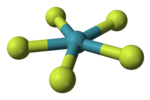Tetramethylammonium pentafluoroxenate

| |||
| |||
| Names | |||
|---|---|---|---|
| IUPAC name
Tetramethylammonium pentafluoridoxenonate(−)
| |||
| Other names
Tetramethylammonium pentafluoroxenate(IV)
| |||
| Identifiers | |||
3D model (JSmol)
|
|||
| |||
| |||
| Properties | |||
| [N(CH3)4][XeF5] | |||
| Molar mass | 300.4308 g/mol | ||
Except where otherwise noted, data are given for materials in their standard state (at 25 °C [77 °F], 100 kPa).
| |||
This article needs additional citations for verification. (April 2021) |
Tetramethylammonium pentafluoroxenate is a chemical compound with the chemical formula [N(CH3)4]+[XeF5]−. This salt consists of tetramethylammonium cations [N(CH3)4]+ and pentafluoroxenate(IV) anions [XeF5]−. The [XeF5]− ion was the first example of a pentagonal planar molecular geometry AX5E2 species.[1] It was prepared by the reaction of [N(CH3)4]F with xenon tetrafluoride, [N(CH3)4]F being chosen because it can be prepared in anhydrous form and is readily soluble in organic solvents.[1] The anion is planar, with the fluorine atoms in a slightly distorted pentagonal coordination (Xe–F bond lengths 197.9–203.4 pm, and F–X–F bond angles 71.5°–72.3°).[1] Other salts have been prepared with sodium, caesium and rubidium, and vibrational spectra show that these contain the same planar ion.[1] The isolated anion has the point group of D5h.[1]
References
- ^ a b c d e Christe, K. O.; Curtis, E. C.; Dixon, D. A.; Mercier, H. P.; Sanders, J. C. P.; Schrobilgen, G. J. (1991). "The pentafluoroxenate(IV) anion, XeF−
5: the first example of a pentagonal planar AX5 species". Journal of the American Chemical Society. 113 (9): 3351–3361. doi:10.1021/ja00009a021.




